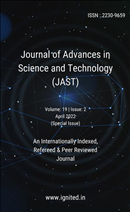A Study of EHO-FF Algorithms for Optimal Distribution Energy Resources Sizing.
DOI:
https://doi.org/10.29070/py82q112Keywords:
Smart Grid, Demand Side Management, Distributed Energy Resources, Reactive Power Optimisation, hybrid evolutionary algorithm, PSOAbstract
The advent of the Smart Grid idea has presented a significant obstacle in the power industry. The smart grid now mostly consists of distributed power that integrates renewable energy resources. Demand Side Management (DSM) adapts to fluctuating demand by letting customers choose their own power generation options. By limiting demand & maximising resource allocation for power generation, DSM enables customers to access power at a reduced cost. Developing a hybrid evolutionary algorithm for DSM that accurately monitors smart grid real power loss is the main goal of this study. This method will be useful for reactive power optimisation, or RPO. Improving the power grid network's energy efficiency and voltage profile under various load situations is the goal of the proposed effort.
Downloads
References
Arif, S. M., Hussain, A., Lie, T. T., Ahsan, S. M., & Khan, H. A. (2020). Analytical hybrid particle swarm optimization algorithm for optimal siting and sizing of distributed generation in smart grid. Journal of Modern Power Systems and Clean Energy, 8(6), 1221-1230.
Bose, 2010, ‘ Smart transmission grid application and their supporting infrastructure’. A Smart Grid, IEEE Transactions on Volume: 1, Issue: 1. pp.11-19.
Calafate, C.T. 2009, ‘Qos support in MANET: a modular architecture based on the IEEE 802.11e technology’. Circuits and Systems for Video Technology, IEEE Transactions on Volume:19 , Issue: 5 pp.678-692.
Di Barba, P, Dughiero, F, Forzan, M & Sieni, E, 2018, ‗ELF-adaptive Migration-NSGA algorithm: An application in uncertainty-tolerant magnetic field synthesis for MFH inductor design‘, International Journal of Applied Electromagnetic and Mechanics, pp. 1-16.
Dsouza, A. K., & MV, L. K. (2020). A hybrid approach for enhancing and optimizing the power quality and power flow in Smart Grid Connected System. Systems Engineering, 26(2), 133-148.
Duman, S, Rivera, S, Li, J & Wu, L 2020, ‘Optimal power flow of power systems with controllable wind-photovoltaic energy systems via differential evolutionary particle swarm optimization’, International Transactions on Electrical Energy Systems, vol. 30, no. 4, pp. 1-28.
Enshaee, A, Hooshmand, R.A & Fesharaki, F.H 2012, ‗A new method for optimal placement of phasor measurement units to maintain full network observability under various contingencies‘. Electric Power Systems Research, vol. 89, pp. 1-10.
Falconer, D., Ariyavisitakul, S.L., Benyamin-Seeyar, A. and Eidson, B. April 2002, Frequency domain equalization for single-carrier broadband wireless systems , Communications Magazine, IEEE , Vol.40, No.4, pp.58-66.
Ghasemi, M, Ghavidel, S, Ghanbarian, MM & Gitizadeh, M 2015b, ‘Multi-objective optimal electric power planning in the power system using Gaussian bare-bones imperialist competitive algorithm’, Information Sciences, vol. 294, pp. 286-304.
Ghasemi, M, Ghavidel, S, Ghanbarian, MM, Gharibzadeh, M & Vahed, AA 2014c, ‘Multi-objective optimal power flow considering the cost, emission, voltage deviation and power losses using multi-objective modified imperialist competitive algorithm’, Energy, vol. 78, pp. 276-289
Ghasemi, M, Ghavidel, S, Rahmani, S, Roosta, A & Falah, H 2014a, ‘A novel hybrid algorithm of imperialist competitive algorithm and teaching learning algorithm for optimal power flow problem with non-smooth cost functions’, Engineering Applications of Artificial Intelligence, vol. 29, pp. 54-69.
Hajian, M, Ranjbar, A.M, Amraee, T & Mozafari, B 2011, ‗Optimal placement of PMUs to maintain network observability using a modified BPSO algorithm‘, International Journal of Electrical Power & Energy Systems, vol. 33, no. 1, pp. 28-34.
Huang, L, Sun, Y., Xu, J. Gao, W, Zhang, J & Wu, Z 2014, ‗Optimal PMU placement considering controlled islanding of power system‘, IEEE Trans. Power Syst, vol. 29, no. 2, pp. 742-755.
Jamuna, K & Swarup K.S 2011, ‗Optimal Placement of PMU & SCADA measurements for security constrained state estimation‘, International Journal of Electric Power & Energy system, vol. 33, pp. 1658-1665.
Kannayeram, G. P., Muniraj, R., Prakash, N. B., Jarin, T., & Boselin Prabhu, S. R. (2021). An elitist control scheme for power flow management in smart grid system: a hybrid optimization scheme. Energy Sources, Part A: Recovery, Utilization, and Environmental Effects, 1-22.
Kessel, P. and Glavitsch, H. (1986). Estimating the voltage stability of a power system. IEEE Transactions on Power Delivery., 1(3):346-354.
Kumar, AR & Premalatha, L 2015, ‘Optimal power flow for a deregulated power system using adaptive real coded biogeography-based optimization’, International Journal of Electrical Power & Energy Systems, vol. 73, pp. 393-399.
Kumar, S, Tyagi, B, Kumar, V & Chohan, S, 2018, ‗Incremental PMU placement considering reliability of power system network using analytical hierarchical process‘, IET Generation, Transmission & Distribution, vol. 12, no. 16, pp. 3900-3909.
Manoharan, H, Srikrishna, S, Sivarajan, G & Manoharan, A 2018. ‗Economical placement of PMUs considering observability and voltage stability using binary coded ant lion optimization‘, International Transactions on Electrical Energy Systems, p.e2591
Zehar, K & Sayah, S 2008, ‘Optimal power flow with environmental constraint using a fast successive linear programming algorithm: Application to the Algerian power system’, Energy Conversion and Management, vol. 49, no. 11, pp. 3362-3366.
Zhang, Q & Li, H 2007, ‘MOEA/D: A Multi-Objective Evolutionary Algorithm based on Decomposition’, IEEE Transactions on Evolutionary Computation, vol. 11, no. 6, pp. 712-731.
Zhao, Y, Cai, Y & Cheng, D 2017, ‗A novel local exploitation scheme for conditionally breeding real-coded genetic algorithm‘, Multimedia Tools and Applications, vol. 76, no. 17, pp.17955-17969.






